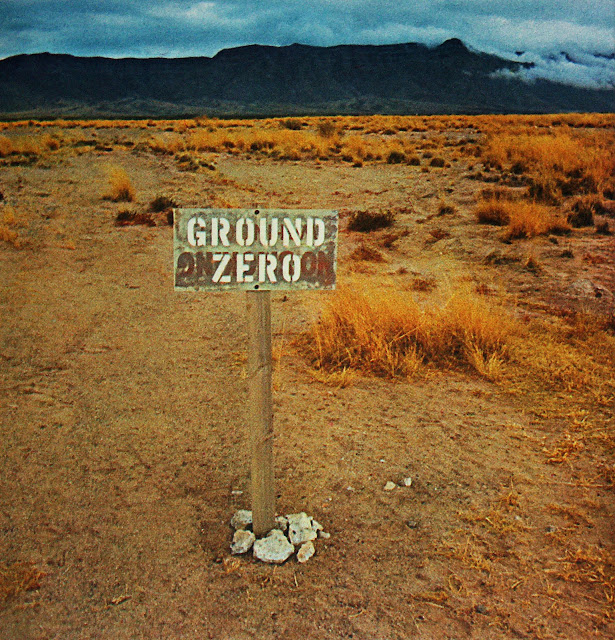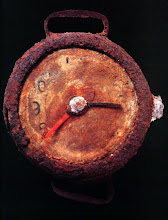A juvenile albatross
desiccate on sand, feathers cupping the fist of flotsam that starved it. As the
biosphere melts down and species disappear forever, Chris Jordan documents the
real appearance-forms of accumulation. On Midway Atoll (Pihemanu Kauihelani in Hawaiian), in the middle of the North Pacific, he photographed the carcasses of albatrosses killed by plastic.
These are hard images, documents of barbarism in Benjamin’s sense: alarms that
call us to awake.
This archive, which Jordan
subtitles Message from the Gyre,
is a lesson in dialectics. In a forensic sense, these images are evidence of a
deadly process: capitalist modernity interacting with and transforming
‘nature’. In the commodity, capital animates and inspirits dead things with
living relations: they are made to move and dance and flow on a global scale.
Here, in these images, we can see in a flash the terrible, indifferent truth of
this social process: accumulation, our master, grows within life like an
incubus. The commodity – or its traces and refuse – acquires its life at the
expense of life, a process that ends in the starvation of living things and the
slow disappearance of life-forms. Modernity has launched a new mass extinction
event, which now, steadily, comes into view.
The plague of plastic now
reaches everywhere. Last year, off Akamas, in the northwest corner of Cyprus, a
drifting gyre of plastic soup came close to shore. With a mask or goggles, you
could see that the first half-meter below the sea’s surface is full of small
plastic fragments, from tiny colored crumbs to finger-sized translucent shreds.
Many, hanging suspended in the sunlit water, look uncannily like plankton,
marine eggs or jellyfish. Having seen that, it’s no surprise to learn that fish, seabirds,
turtles and marine mammals are filling their stomachs with plastic. On some
parts of the shore, the sand and pebbles are filling in with pastel grains of
plastic.
Albatrosses are surface
feeders. After sighting their prey – squid, cuttlefish, jellyfish, small fish
and fish eggs, crustacea and offal – they land on the water and catch it while
floating or swimming. Once they leave the nest, young albatrosses go to sea and
must teach themselves how to do this. If they survive, they won’t touch land
again for a year.
Nine hundred miles north of
Honolulu, Laysan (Kauo in Hawaiian) is a tiny remote island also, like Midway, in the leeward chain. Albatrosses gather there to breed and nest. Along with real food, the
parent birds are bringing plastic flotsam back to the nests and feeding it to
their chicks. Carcasses of starved nestlings include bottle caps, fishing
lures, cigarette lighters, even golf balls, among accumulations of smaller
fragments of plastic. One study found that 97.5 % of chicks had plastic in
their stomachs. Four in ten starve of it on the nest.
 |
| Contents of one Laysan albatross carcass |
The indifference with
which these animals suffer and starve to death is obscene, and reflects the
indifference of capital accumulation, the sheer, impersonal power of social
forces and dynamics. Yes, we can and should bring our own cotton bags to the
grocery store or farmers market. But we know this is merely a gesture, a placebo to assuage us in
the awareness of our own entanglement in a vast and global process. It is the
master logic of that process itself that we need to confront, restrain, resist,
transform and escape. No easy order. It begins, probably, only when we confront
our own addictive enjoyments and, perhaps, our repressed sorrow for the damage
and violence we unconsciously know we are involved in.
These sentences are cold
commentary. In truth these images of ecocide call for warm-blooded grieving.
These birds, we know, are but the visible tip of a process that mostly unfolds
beyond our view or awareness. But we know, too, our shared complicity with the
secret. Although we collectively killed them, these living beings died slow
agonizing deaths without our respect, attention or concern. That, surely, is our
ethical failing. How can we begin to take responsibility for that? How to
express the wound we ourselves should feel in the face of this ongoing loss?
What kind of singing or keening, in place of words such as these, would unlock
the plastic blockage in our hearts? When the last albatross starves, how will
we mourn it? With miming and rhyming, another poem?
The tightening plight, the
endgames of art, the awful indictment of the ‘after’: the need to change what
so far has been unchangeable. In a continuum of disastrous domination, the need
for a ‘real state of exception’.
Helplessness is a headlock
to be slipped. Practices in the wrack: lines of flight, struggles,
solidarities. For the human and nonhuman alike: respect, concern, compassion. Productive mourning: to build and plant and tend, now, against the flow. To render care. Rescue,
refuge, sanctuary: these are passwords of the day.
GR
 |
| Wandering albatrosses, South Georgia Island. Photos: Frans Lanting |






No comments:
Post a Comment